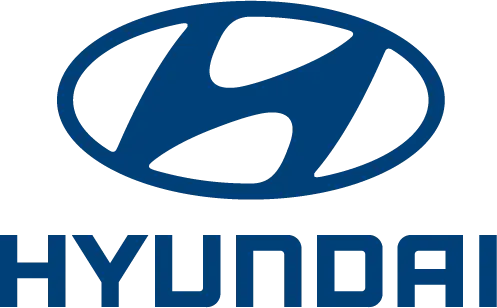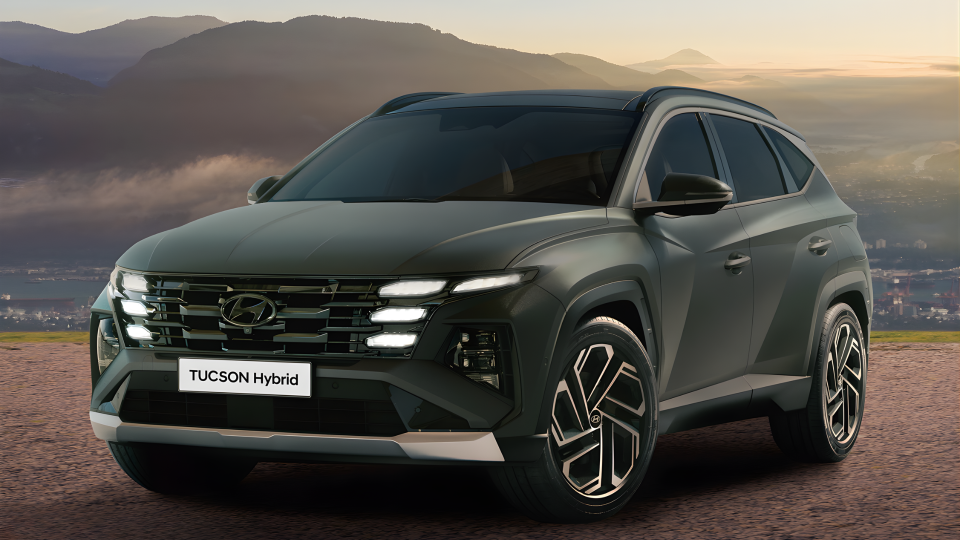The 2026 Hyundai Tucson continues to deliver strong fuel economy for a gas-powered SUV, offering an efficient drive whether in the city or on the highway. EPA estimates for the standard 2.5L engine are 25 MPG city, 33 MPG highway, and 28 MPG combined with front-wheel drive. Even when equipped with Hyundai’s available HTRAC all-wheel-drive system, it maintains competitive ratings of 24 MPG city, 30 MPG highway, and 26 MPG combined — proof that capability and efficiency can go hand in hand.
The compact SUV segment remains one of the most competitive, and two models consistently at the top of the list are the Hyundai Tucson and Toyota RAV4. For 2026, both return with major updates that make the choice more interesting than ever.
The redesigned Hyundai Tucson brings a bold new look, a refined standard engine, and a technology suite that feels more premium than many rivals.
On the other side, the Toyota RAV4 enters its sixth generation with an all-new design and an exclusive shift to hybrid and plug-in hybrid powertrains.
In this side-by-side comparison, we’ll look at how the 2026 Tucson and 2026 RAV4 compare in styling, performance, efficiency, and everyday usability, so you can decide which one fits your lifestyle best.
Table of Contents
- Side-by-Side Feature Comparison
- Performance and Powertrains
- Towing and Utility
- Fuel Economy and Efficiency
- Exterior Design and Styling
- 2026 Hyundai Tucson and Toyota RAV4 Trim Level Overview
- Interior Comfort and Technology
- Interior Dimensions and Passenger Space
- Cargo Space and Practicality
- Safety and Driver-Assistance
- Warranty and Ownership Value
- The Verdict: Which 2026 SUV Is the Right Choice for You?
Side-by-Side Feature Comparison of the 2026 Hyundai Tucson and 2026 Toyota RAV4
| Feature | 2026 Hyundai Tucson | 2026 Toyota RAV4 |
|---|---|---|
| Standard Powertrain | 2.5L Gasoline | 2.5L Hybrid (HEV) |
| Max Available Horsepower | 187 hp (Gas) / 268 hp (PHEV) | 320 hp (PHEV) |
| Drivetrain Options | FWD / HTRAC AWD | FWD / AWD |
| Maximum Cargo Space | 80.3 cu. ft. | To Be Announced |
| Largest Infotainment Screen | 12.3 inches | 12.9 inches |
| Powertrain Warranty | 10 Years / 100,000 Miles | 5 Years / 60,000 Miles |
Performance and Powertrains of the 2026 Hyundai Tucson and the 2026 Toyota RAV4
At the heart of the 2026 Tucson and RAV4 comparison is a fundamental difference in powertrain strategy. Hyundai allows buyers to have a choice, leading with a gasoline engine, while Toyota only provides hybrid technology for every RAV4 buyer.
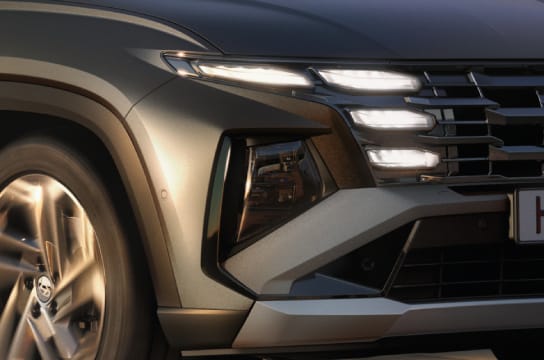
The Hyundai Tucson's Proven Power
The 2026 Hyundai Tucson comes
standard with a potent and reliable
2.5-liter inline 4-cylinder engine,
producing a solid
187 horsepower and
178 lb-ft of torque. This
engine is paired with a sophisticated
8-speed automatic transmission
featuring
SHIFTRONIC manual-shift capability.
This combination is engineered for
smooth, linear power delivery,
providing confident acceleration for merging onto highways and
responsive performance for navigating city streets. Unlike some
competitors that use
continuously variable transmissions (CVTs),
the Tucson’s traditional 8-speed automatic offers a
more direct and engaging driving feel,
with crisp, predictable shifts that many drivers prefer.
For Oklahoma’s varied weather, the availability of Hyundai’s
HTRAC All-Wheel Drive system is
a significant advantage. This intelligent AWD system actively
distributes power between the front and rear wheels to optimize
traction and handling in real-time. Whether you’re facing a sudden
summer downpour or one of our rare but slick winter storms,
HTRAC provides an extra layer
of confidence and stability on the road.
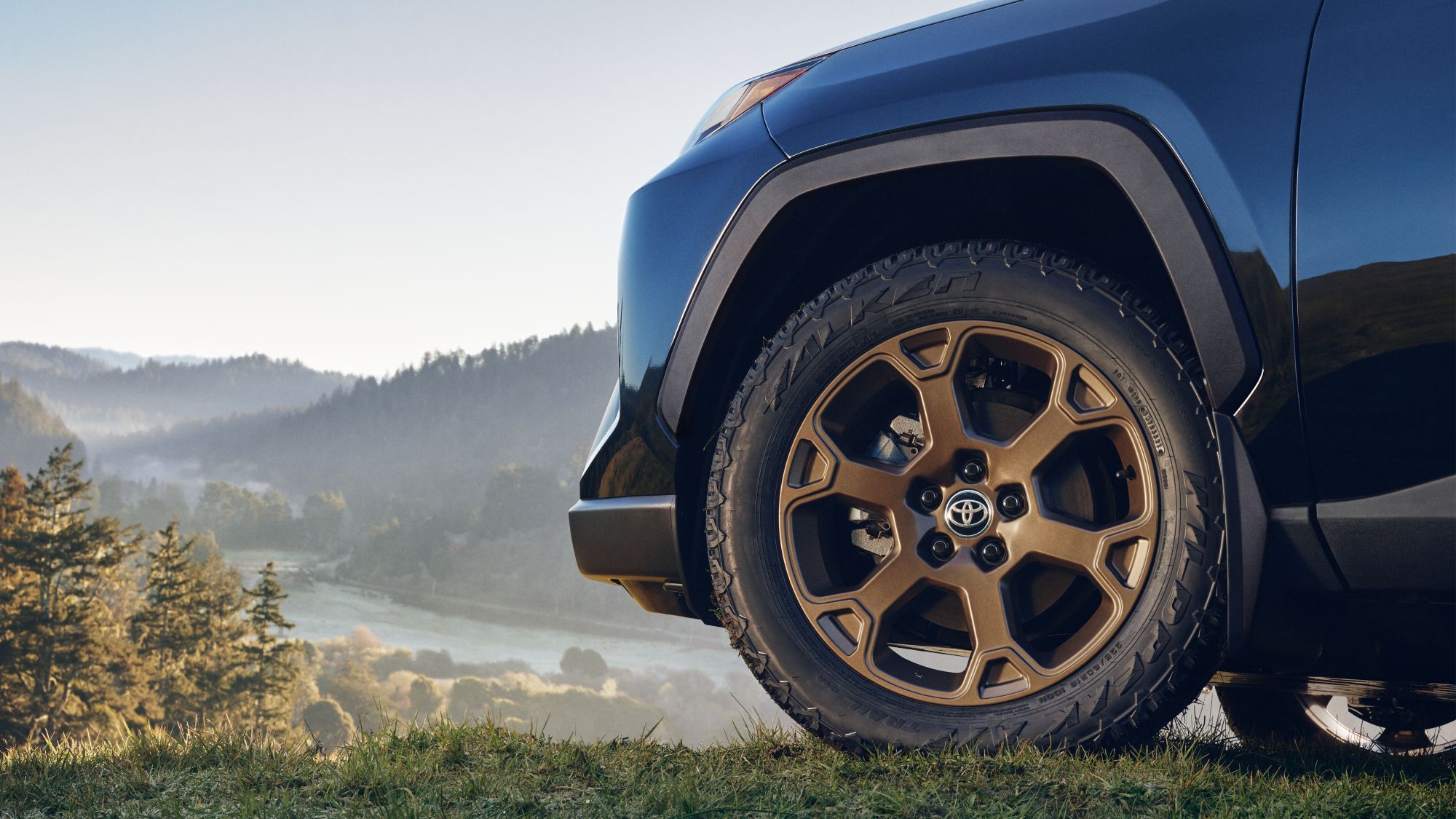
The Toyota RAV4's Electrified Approach
The 2026 Toyota RAV4 has gone
all-in on electrification. The
standard powertrain across the lineup is now a
fifth-generation Hybrid Electric Vehicle (HEV)
system. This system pairs a
2.5-liter 4-cylinder engine
with electric motors to produce
226 combined horsepower (FWD)
or
236 horsepower (AWD). While
these numbers are higher than Tucson’s standard engine, they are
achieved through a more complex interplay of gasoline and electric
power.
For those seeking maximum performance, Toyota offers a
Plug-in Hybrid (PHEV) powertrain
that delivers an impressive
320 combined horsepower. This
option provides rapid acceleration but comes at a significant
price premium and adds the complexity of a larger battery and the
need for external charging to realize its full potential. While
the horsepower figures are headline-grabbing, the actual driving
experience of the standard
RAV4 HEV will be the reality
for most buyers, defined by the unique characteristics of a hybrid
system and its electronically controlled transmission.
Towing and Utility
For many SUV owners, the ability to tow is very important.
2026 Hyundai Tucson
The 2026 Tucson excels here, offering a strong and consistent towing capacity of up to 2,750 pounds with trailer brakes, powered by its standard 2.5L engine. This makes it more than capable of handling a small boat for a weekend at Lake Hefner or a utility trailer for a home improvement project.
2026 Toyota RAV4
The RAV4's towing capabilities are more fragmented. While certain high-end AWD HEV and PHEV models can tow up to 3,500 pounds, the FWD models and the base LE AWD model are limited to just 1,750 pounds. This means that to get maximum utility from the RAV4, buyers are forced into more expensive, all-wheel-drive configurations. The Tucson, by contrast, provides robust towing capacity as a core feature, reinforcing its value and straightforward capability.
2026 Tucson vs RAV4: Engine, Drivetrain, and Towing Specs
| Specification | 2026 Hyundai Tucson (Standard) | 2026 Toyota RAV4 (Standard HEV) | 2026 Toyota RAV4 (Available PHEV) |
|---|---|---|---|
| Engine Type | 2.5L Inline 4-Cylinder Gas | 2.5L Inline 4-Cylinder Hybrid | 2.5L Inline 4-Cylinder Plug-in Hybrid |
| Transmission | 8-Speed Automatic with SHIFTRONIC | Electronically Controlled CVT (eCVT) | Electronically Controlled CVT (eCVT) |
| Standard Drivetrain | Front-Wheel Drive (FWD) | Front-Wheel Drive (FWD) | All-Wheel Drive (AWD) |
| Available Drivetrain | HTRAC All-Wheel Drive (AWD) | All-Wheel Drive (AWD) | - |
| Max Towing Capacity | 2,750 lbs (with trailer brakes) | 1,750 - 3,000 lbs (trim dependent) | 1,750 - 3,000 lbs (trim dependent) |
Fuel Economy and Efficiency of the 2026 Hyundai Tucson and the 2026 Toyota RAV 4
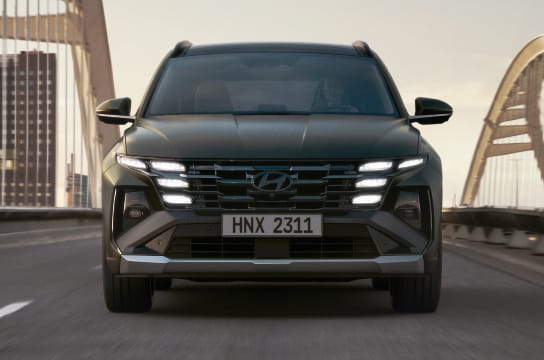
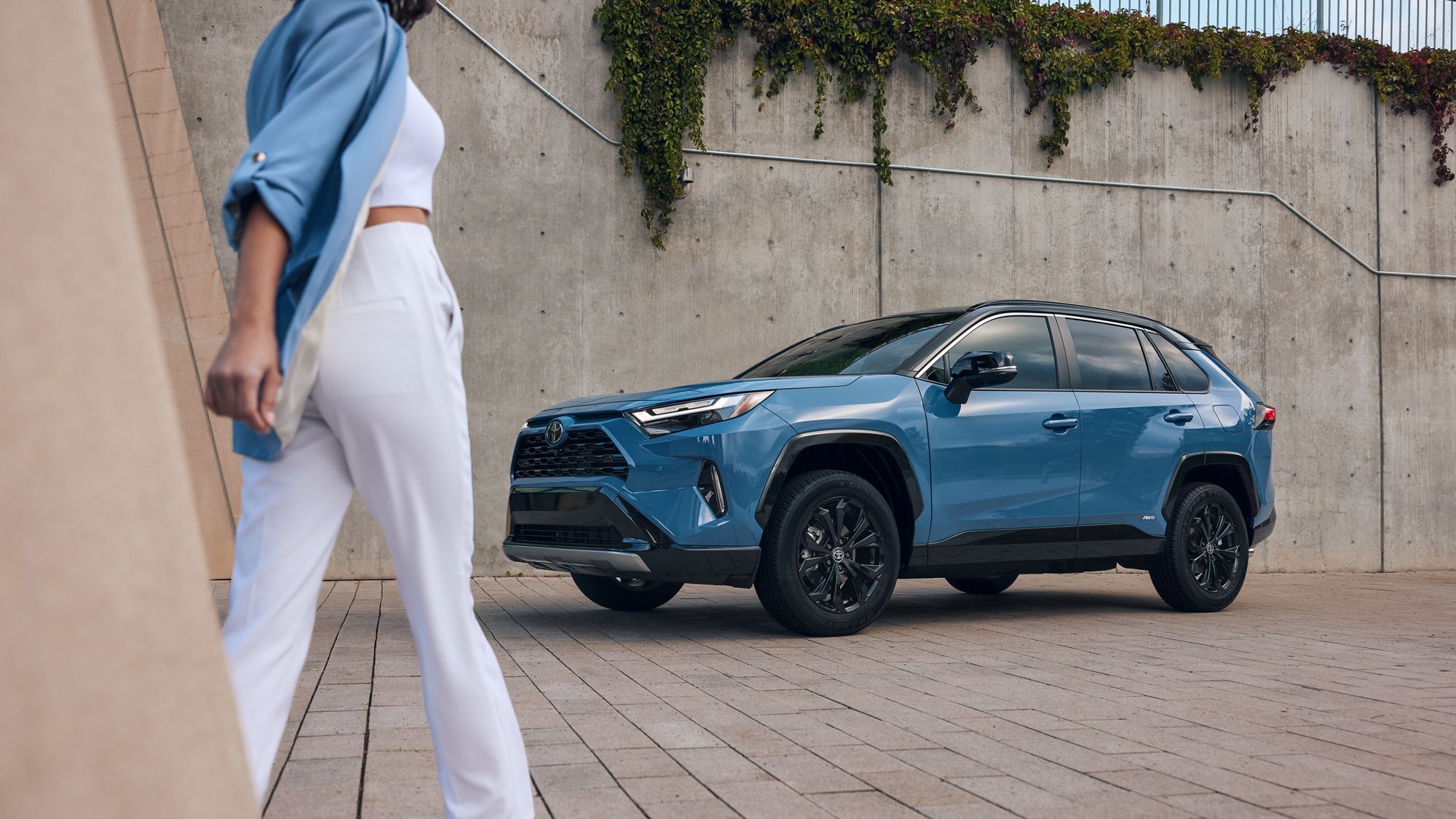
The 2026 Toyota RAV4, with its hybrid and plug-in hybrid options, is expected to achieve higher MPG ratings overall. However, that efficiency depends on maintaining hybrid or electric operation, which may vary based on driving conditions and trip lengths.
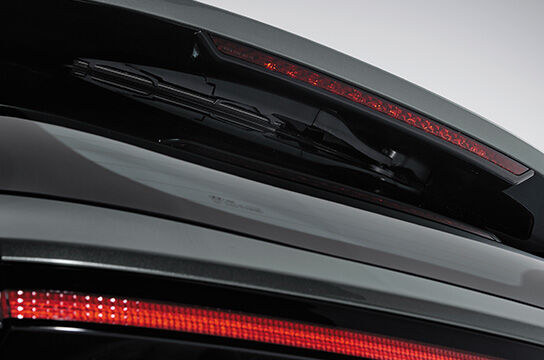
For most drivers, the Tucson’s consistent fuel economy, combined with its straightforward gasoline powertrain, makes it an easier and more dependable everyday choice — no charging, no special maintenance, and no trade-offs in performance.
Exterior Design and Styling of the 2026 Hyundai Tucson and 2026 Toyota RAV4
Both SUVs have been completely redesigned for 2026, but they take dramatically different approaches to styling. The Tucson makes a singular, bold statement, while the RAV4 offers a menu of different personalities.
The 2026 Hyundai Tucsonis a masterpiece of modern design. Its “Parametric Dynamics” philosophy creates a visually stunning exterior with sharp, intersecting lines and chiseled surfaces that look like nothing else on the road. The most dramatic feature is the front grille, which seamlessly integrates the signature LED Daytime Running Lights. When the vehicle is off, they blend into the dark chrome grille; when it’s on, they illuminate in a breathtaking wing-like pattern.
This cohesive and futuristic design language carries across the entire lineup. For those seeking a more assertive look, the XRT trim adds exclusive 18-inch alloy wheels, rugged side cladding, and a premium dark chrome accent grille, enhancing the Tucson's adventurous spirit without compromising its sophisticated core design. The Tucson’s design is confident and forward-thinking, making a strong, unified statement of style.
On the other hand, for 2026, Toyota has split the RAV4's identity into three distinct visual themes: Core, Rugged, and Sport. The “Core” models (LE, XLE, Limited) feature a refined, modern look with a clean “hammerhead” front end and body-colored details, aimed at the traditional SUV buyer.
The “Rugged” theme is embodied by the Woodland trim, which gets a raised ride height, all-terrain tires, prominent black cladding, and adventure-focused accessories like raised roof rails. Finally, the “Sport” lineup (SE, XSE, and the new GR Sport) offers a more aggressive stance, with features like two-tone paint options, larger wheels up to 20 inches, and aerodynamic enhancements.
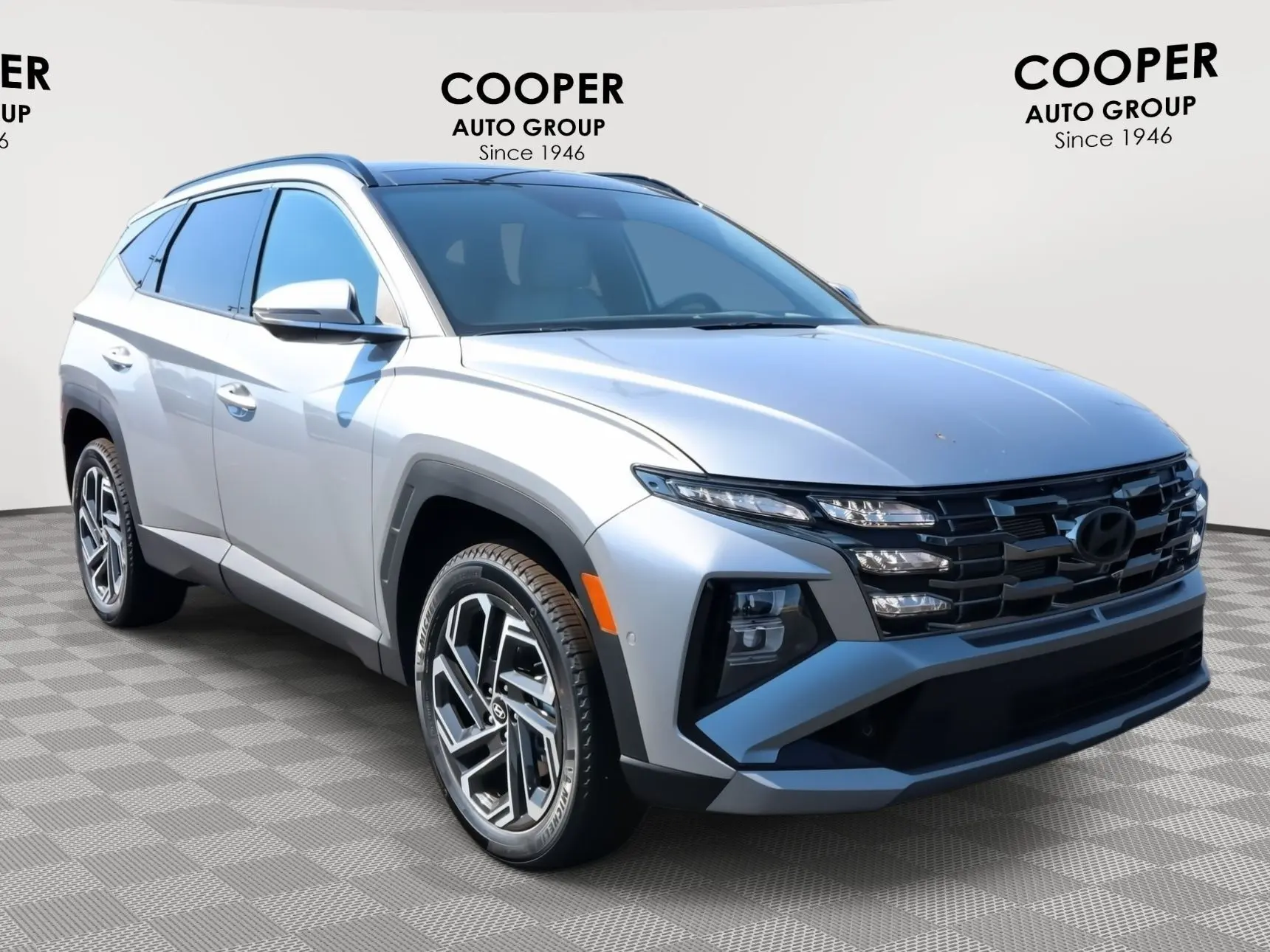

2026 Hyundai Tucson and Toyota RAV4 Trim Level Overview
2026 Hyundai Tucson Trims
- SE
Base model with a 2.5L engine, front-wheel drive (HTRAC AWD optional), and core tech like an 8-inch touchscreen with wireless Apple CarPlay®/Android Auto™. Standard Hyundai SmartSense safety features included.
-
This trim adds popular amenities such as larger 19-inch alloy wheels and convenient wireless device charging, on top of the SE’s features. Optional HTRAC AWD is available for enhanced traction, making this trim a balanced mix of comfort and capability.
- SEL Premium
The SEL Premium introduces more upscale conveniences like a hands-free smart power liftgate (auto open) and a power tilt-and-slide sunroof, bringing extra ease and style to the Tucson. These premium additions build on the SEL, appealing to those wanting a near-luxury feel without going to the top trim.
- XRT
An adventure-themed trim with rugged styling tweaks. It stands out with XRT-exclusive 18-inch black alloy wheels and unique exterior cladding, along with black mirror caps and special XRT badging for a tougher look. The XRT shares much of its equipment with mid-level trims but adds a bold, off-road-inspired appearance.
-
This trim features upscale upgrades like a Bose® premium audio system and a wide panoramic sunroof, plus refined touches such as a heated, leather-wrapped steering wheel. The Limited comes only with the most advanced tech and comfort features in the Tucson lineup. It has every available option, delivering a true luxury experience in this compact SUV.
2026 Toyota RAV4 Trims
- LE
Core base hybrid model (now 100% electrified lineup) offered with either FWD or AWD. Even as the entry trim, it’s well-equipped, coming standard with the new Toyota Safety Sense 4.0 suite and a fully digital 12.3-inch driver’s gauge cluster for a modern cockpit
- XLE
The popular mid-tier hybrid trim (also available with FWD or AWD) that builds on the LE with more convenience and comfort features. It offers an upgraded interior and additional amenities (like improved upholstery and available moonroof), while retaining all the core tech and safety equipment from the LE
- Woodland
An all-new rugged hybrid trim (AWD-only) with an outdoorsy focus. The Woodland edition boasts exclusive details such as an Urban Rock exterior paint color only offered on this grade, and an adventure-ready interior featuring unique textured trim with red-orange accents, plus standard all-weather floor/cargo mats
- SE
A sport-oriented trim (hybrid, available with FWD or AWD) that brings a dynamic look and feel. The SE grade features sporty touches like blue interior contrast stitching and an available two-tone exterior (e.g., black roof) option, along with larger alloy wheels for a more aggressive stance. It’s the entry into RAV4’s new Sport design theme.
- XSE
The premium sport hybrid trim (AWD-only) that builds on the SE’s athletic style with extra flair and tech. XSE upgrades the cabin with Ultrasuede® and SofTex®-trimmed seats for an upscale sporty interior feel. It also offers eye-catching extras like an available contrasting black roof and the biggest wheels (up to 20-inch) in the lineup for a bold appearance.
- Limited
The range-topping hybrid trim focuses on delivering maximum luxury and technology (AWD-only). It comes with premium touches such as leatherette SofTex® seating and is the only hybrid trim to offer a Head-Up Display for the driver.
- GR Sport
A new performance-tuned Plug-in Hybrid (PHEV) model (AWD standard) at the top of the RAV4 lineup. The GR Sport edition adds exclusive Toyota Gazoo Racing touches: it gets perforated microsuede (BRIN•NAUB®) + SofTex® sport seats embossed with GR logos, plus race-inspired details like steering-wheel paddle shifters and aluminum sport pedals for a high-performance vibe.
Interior Comfort and Technology of the 2026 Hyundai Tucson and the 2026 Toyota RAV4
The cabin is where drivers spend their time, and in 2026, both Hyundai and Toyota have made significant technological leaps. However, their philosophies on user experience reveal a key advantage for the Tucson.
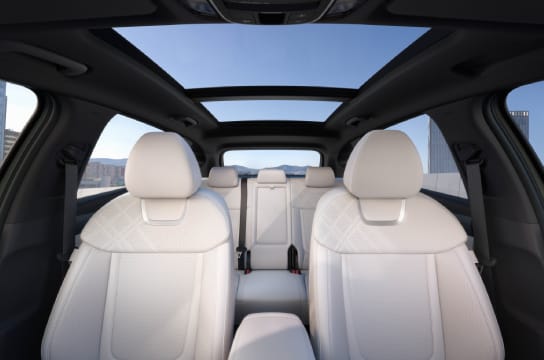
The Tucson's Digital Cockpit
Stepping into the 2026 Tucson feels like entering a vehicle from the future. The dashboard is dominated by a single, monolithic panel that houses two brilliant 12.3-inch screens—one for the fully digital and configurable instrument cluster, and the other for the high-definition infotainment system. This clean, minimalist design creates an immersive and upscale environment.
Crucially, Hyundai’s designers understood that not every control belongs on a touchscreen. The Tucson’s center stack features much-appreciated physical dials and buttons for essential functions like climate control and audio volume. This thoughtful, human-centric approach allows for quick, tactile adjustments without diverting the driver’s eyes from the road—a significant ergonomic and safety advantage.
Standard wireless Apple CarPlay and Android Auto, an available Bose premium audio system, and luxurious amenities like heated and ventilated seats, a heated steering wheel, and a large panoramic sunroof complete a cabin experience that is both technologically advanced and intuitively designed.
The RAV4’s Tech Upgrade
The 2026 RAV4 also boasts an impressive new interior. A 12.3-inch digital gauge cluster is now standard across all trims, providing crisp, customizable driving information. The center stack features a new floating touchscreen, available in either a 10.5-inch or a massive 12.9-inch size. Like the Tucson, the RAV4 offers standard wireless Apple CarPlay and Android Auto compatibility and an available JBL premium audio system.
However, Toyota has opted for a more screen-centric control philosophy. The new interface integrates the digital HVAC controls into a permanent bar at the bottom of the touchscreen. While this creates a clean look, it means that adjusting the temperature or fan speed on a hot Oklahoma summer day requires interacting with the screen rather than turning a simple, familiar knob. This can be more distracting and less intuitive than the Tucson's blended approach.
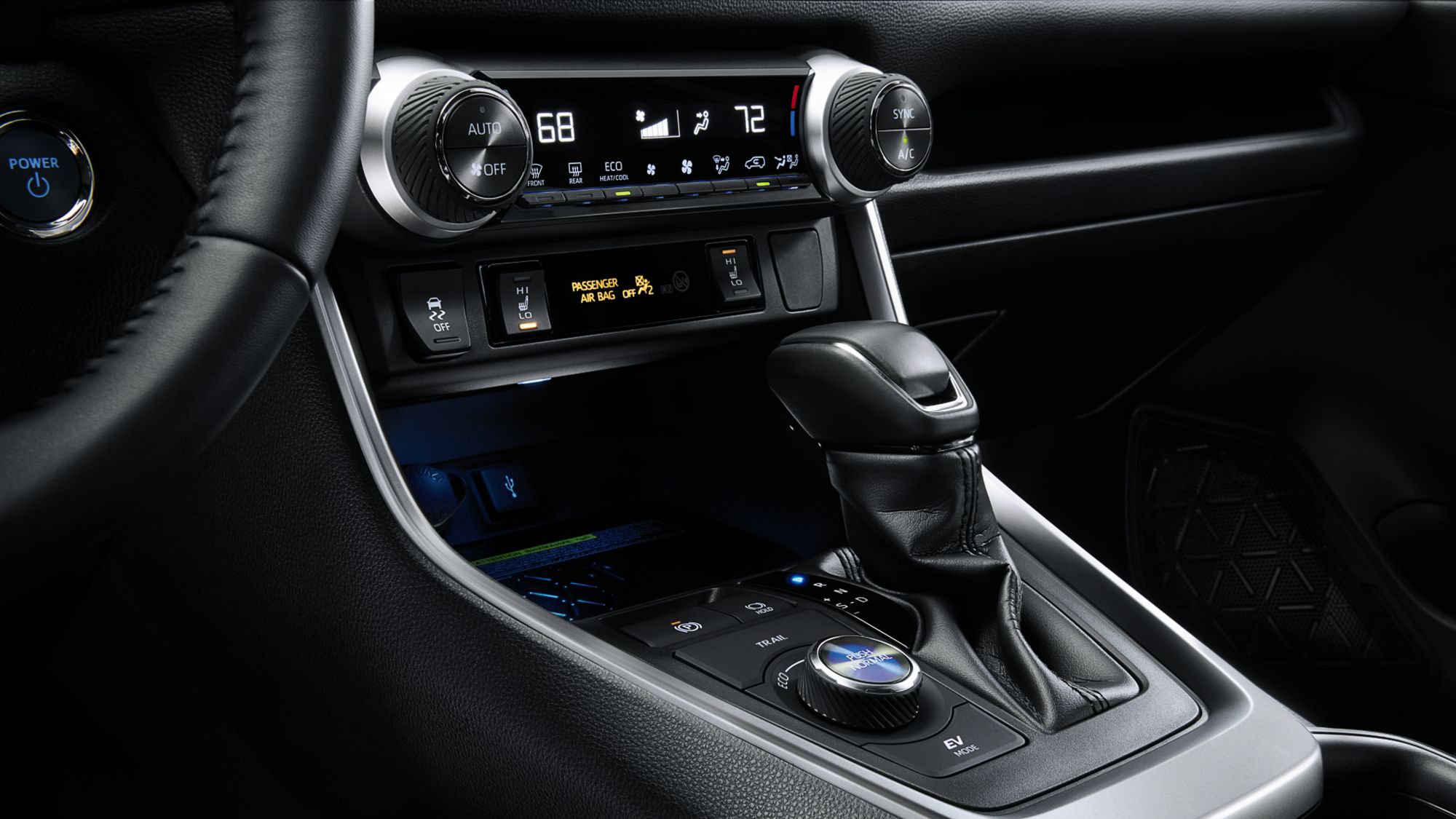
Interior Dimensions and Passenger Space of the 2026 Hyundai Tucson
Both SUVs offer comfortable seating for five adults, but the Tucson's intelligent packaging gives it an edge in crucial areas, particularly for rear-seat passengers. With nearly identical front legroom, the Tucson provides an impressive 41.3 inches of rear legroom, ensuring that even taller passengers have ample space to stretch out on long trips.
| Dimension | 2026 Hyundai Tucson |
|---|---|
| Front Headroom | Up to 40.1 in. |
| Rear Headroom | Up to 39.5 in. |
| Front Legroom | 41.4 in. |
| Rear Legroom | 41.3 in. |
| Front Shoulder Room | 57.6 in. |
| Rear Shoulder Room | 56.0 in. |
| Passenger Volume | 108.2 cu. ft. |
Cargo Space and Practicality of the 2026 Hyundai Tucson
A primary reason for choosing an SUV is its versatility, and cargo capacity is a non-negotiable metric. Here, the 2026 Hyundai Tucson establishes a clear and commanding lead with known, class-leading dimensions.
The Tucson offers a cavernous 38.7 to 39 cubic feet of cargo space behind the 60/40 split-folding rear seats. This is more than enough room for luggage, groceries, or sports equipment. When more space is needed, the rear seats fold down to open up a massive 80.3 cubic feet of maximum cargo volume, rivaling that of some midsize SUVs.
This expansive and flexible space is made even more accessible by the available hands-free smart liftgate, which opens automatically when the proximity key is detected nearby, a perfect feature for when your hands are full.
The cargo dimensions for the all-new 2026 RAV4 have not yet been officially released by Toyota, with descriptions limited to a "highly usable rear cargo area". While Toyota's engineers are adept at packaging, the mandatory hybrid and PHEV powertrains introduce a fundamental engineering challenge.
The large battery packs required for these systems often intrude upon cargo space or raise the height of the load floor. For families who need to haul everything from camping gear to band instruments, the Tucson’s confirmed and capacious cargo hold is the proven choice.
| Cargo Metric | 2026 Hyundai Tucson |
|---|---|
| Cargo Volume (Rear Seats Up) | Up to 39 cu. ft. |
| Cargo Volume (Rear Seats Down) | Up to 80.3 cu. ft. |
Safety and Driver-Assistance
Both Hyundai and Toyota have earned reputations for safety, and both the 2026 Tucson and RAV4 come equipped with an impressive array of standard and available driver-assistance technologies. While both are exceptionally safe, Hyundai’s approach often provides more of these advanced features on more accessible trim levels, delivering superior value.
Hyundai SmartSense Suite
Every 2026 Tucson is equipped with the Hyundai SmartSense suite of
safety features. Standard systems include Forward
Collision-Avoidance Assist (FCA) with Pedestrian, Cyclist, and
Junction-Turning Detection, which can warn the driver and
automatically apply the brakes to help prevent a collision. Also
standard are Lane Keeping Assist (LKA) and Blind-Spot Collision
Warning (BCW).
Moving up to popular trims like
the SEL
adds even more, such as Blind-Spot Collision-Avoidance Assist and Rear Cross-Traffic
Collision-Avoidance Assist. Available advanced technologies like Highway Driving Assist (HDA),
a Surround View Monitor, and the Blind-Spot View Monitor — which displays a live camera feed
of your blind spot in the instrument cluster — make driving in heavy traffic less stressful
and safer.
Furthermore, the Tucson’s available Smart Cruise Control with Stop
& Go is noted for its smooth, human-like responses, avoiding the
jerky or overly cautious behavior of some competitor systems.
Toyota Safety Sense 4.0
The 2026 RAV4 is the launch vehicle for Toyota Safety Sense 4.0
(TSS 4.0), the latest version of the brand’s safety package. This
suite includes an enhanced Pre-Collision System with improved
detection capabilities, a new Front Cross-Traffic Alert for safer
navigation of intersections, and Proactive Driving Assist, which
provides gentle braking and steering support in curves or heavy
traffic.
An available Advanced Lane Change Assist works with the adaptive
cruise control for smoother highway maneuvers, and an Advanced
Park function can automate parking in tight spaces. While TSS 4.0
is comprehensive, the most advanced features are typically
reserved for the highest, most expensive trim levels.
Warranty and Ownership Value
A vehicle's warranty is a direct reflection of the manufacturer's confidence in its product. It is also one of the most critical factors in the long-term cost of ownership and a key indicator of value. In this area, the Hyundai Tucson holds an undisputed advantage.
America's Best Warranty
Hyundai’s industry-leading warranty offers owners unparalleled peace of mind. The 2026 Tucson is covered by:
- A 10-year/100,000-mile Powertrain Limited Warranty.
- A 5-year/60,000-mile New Vehicle Limited Warranty.
- A 7-year/unlimited-mile Anti-Perforation Warranty.
- 5 years of 24/7 Roadside Assistance with unlimited mileage.
In addition, Hyundai provides 3 years or 36,000 miles of Complimentary Maintenance, covering normal, factory-scheduled services like oil changes and tire rotations.
Toyota's Coverage
Toyota offers a solid but significantly shorter warranty package for the 2026 RAV4. Its coverage includes:
- A 5-year/60,000-mile Powertrain Warranty.
- A 3-year/36,000-mile Basic New Vehicle Warranty.
Because the RAV4 is now exclusively hybrid, it includes specific warranties for its electrified components: an 8-year/100,000-mile hybrid system warranty and a 10-year/150,000-mile hybrid battery warranty. Toyota also includes its ToyotaCare plan, which provides complimentary maintenance for 2 years or 25,000 miles.
Hyundai’s powertrain warranty, which covers the most expensive components of the vehicle, like the engine and transmission, lasts twice as long and covers 40,000 more miles than Toyota’s. This is especially significant given the RAV4's move to a more complex, mandatory hybrid system. The Tucson's simpler, proven gasoline engine is backed by a decade of protection, representing a substantially lower financial risk and a more confident long-term investment for its owner.
2026 Hyundai Tucson vs 2026 Toyota RAV4: Warranty and Coverage Comparison
| Coverage | 2026 Hyundai Tucson | 2026 Toyota RAV4 |
|---|---|---|
| Powertrain Warranty | 10 Years / 100,000 Miles | 5 Years / 60,000 Miles |
| Basic (New Vehicle) Warranty | 5 Years / 60,000 Miles | 3 Years / 36,000 Miles |
| Complimentary Maintenance | 3 Years / 36,000 Miles | 2 Years / 25,000 Miles |
| Anti-Perforation Warranty | 7 Years / Unlimited Miles | 5 Years / Unlimited Miles |
| Roadside Assistance | 5 Years / Unlimited Miles | 2 Years / Unlimited Miles |
The Verdict: Which 2026 SUV is the Right Choice for You?
The 2026 Toyota RAV4 is a forward-thinking SUV that leans fully into electrification, offering strong efficiency and advanced hybrid technology. However, its hybrid-only setup comes with trade-offs: a higher starting price, added system complexity, and a shorter warranty.
For most drivers, the 2026 Hyundai Tucson simply makes more sense. It strikes a better balance between practicality, comfort, and long-term value. The Tucson gives buyers real choice, offering a proven gasoline engine that’s both capable and easy to maintain. Inside, it blends modern digital features with intuitive physical controls, creating a cabin that feels upscale yet familiar.
It also delivers class-leading cargo space and everyday versatility that fit seamlessly into family life. And with Hyundai’s 10-year/100,000-mile powertrain warranty, the Tucson offers peace of mind that lasts long after the initial purchase — something the RAV4 doesn’t match.
Experience the Winner at Joe Cooper Hyundai of Midwest City
With its blend of refined design, advanced technology, and proven capability, the 2026 Hyundai Tucson stands out as the clear choice for drivers across Oklahoma. To experience its comfort and performance firsthand, visit Joe Cooper Hyundai of Midwest City, located at 6601 SE 29th St, Midwest City, OK 73110. Our dealership proudly serves the greater Oklahoma City area, including Norman, Moore, Del City, and Choctaw.
At Joe Cooper Hyundai, our team is dedicated to delivering a straightforward and professional buying experience from start to finish. You can schedule a test drive to explore the Tucson’s sophisticated interior, responsive handling, and advanced features, or contact our finance department to discover competitive options that meet a variety of needs.
Also, if the need ever arises, our Hyundai-certified service team is equipped to help you protect your investment with genuine OEM parts and expert maintenance.
Contact us today to get started.
